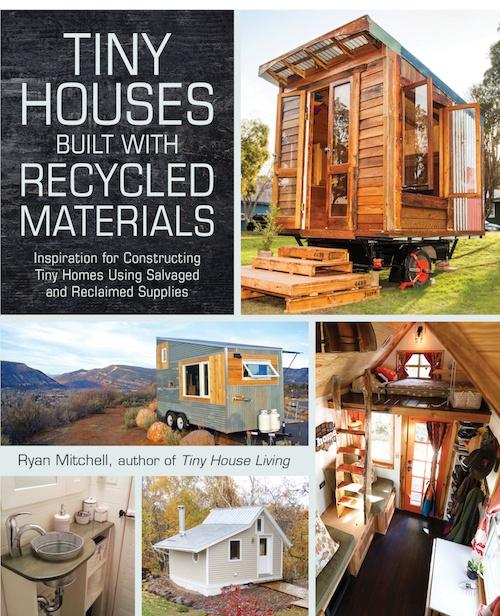
With a busy week behind you and the weekend within reach, there’s no shame in taking things a bit easy on Friday afternoon. With this in mind, every Friday TriplePundit will give you a fun, easy read on a topic you care about. So, take a break from those endless email threads and spend five minutes catching up on the latest trends in sustainability and business.
Well, it seems the tiny house movement is here to stay. Following the trend of oversized 'McMansions' in the 1990s, a growing number of homemakers are shunning unneeded living space in exchange for pint-sized dwellings that house only the essentials.
To celebrate the movement -- and help others who want to get involved --- tiny house enthusiast Ryan Mitchell penned his most recent book, "Tiny Houses Built with Recycled Materials: Inspiration for Constructing Tiny Homes Using Salvaged and Reclaimed Supplies."
A native of Charlotte, North Carolina, Mitchell has followed the tiny house movement for years. He founded The Tiny Life blog in 2009, organizes the annual Tiny House Conference and calls a 150-square-foot structure home. In other words: If you're into tiny houses, Mitchell is your guy.
In his new book, Mitchell takes things a step further by featuring tiny homes constructed from recovered and repurposed building materials. Some are rugged (wait, what do you mean no toilet?), while others are downright sleek. The book includes innovative tiny homes from around the world, and Mitchell was kind enough to share three examples for your weekend reading pleasure. Be warned: You may be suddenly overcome by how excessively large your Manhattan apartment is.
James Galletly: Tiny house on wheels
Location: Crescent Head, New South Wales, Australia
Size: 52 square feet
Completed in 2014
Utilities: Electricity: Solar Heating/Cooling: None Water: None Water Heating: None Stove: None Refrigeration: None Toilet: None Internet: None
James Galletly was visiting a friend in California when he first picked up a book by tiny house publishing legend Lloyd Kahn. “The biggest part of the appeal is the DIY mentality,” Galletly told Mitchell for the book. “People are building their own homes and coming up with designs that are far more original and creative and have more personality than what is normally considered a home.” He took the tiny house idea with him back to his native Australia.
The design of the tiny caravan depended on the materials at hand. “I enjoyed the creative process. I enjoy the interaction between letting the materials dictate the outcome and working with what you’re given,” he said. Galletly went to a local rebuilding center, visited salvage yards and went dumpster diving. He spent a month collecting materials before he started building and kept looking for things throughout the rest of the build. He even set up a chalk board next to the build site, featuring materials he needed, so his neighbors could drop things off -- and they actually did.
The few materials bought new included the house wrap, the electrical wiring, and the nails and screws. Galletly estimates that 95 percent of the tiny house is built with reclaimed materials. He advises builders looking to use secondhand materials to keep an open mind and creatively use the things you find along the way. “It’s the most enjoyable part about secondhand materials. It’s so much easier to work with the textures and the palette you’re given.”
Conrad Rogue: Tiny house on foundation
Location: Jacksonville, Oregon Size: 70 square feet Completed in 2013
Utilities: Electricity: 50-watt solar panel and small battery Heating/Cooling: Olive oil candles and tiny can stove Water: 3-gallon carboy (rain water) Water Heating: None Stove: Single-burner can stove Refrigeration: Cool box on the north side of the cob wall Toilet: None Internet: None
Conrad Rogue is not new to building spaces for himself. Early on in life, he bought some land and built a small cabin, and from that he began a lifelong journey of building eco-friendly homes. Today he focuses on cob homes: earthen structures that are built from a mix of clay, sand and straw.
He now lives in an itsy-bitsy cob house in Jacksonville, Oregon. Rogue told Mitchell with a chuckle that cob is “the original reclaimed material” and the one he most likes to work with. After building and living in many types of structures including a cabin, a teepee, a yurt and a dome house, cob seemed to be just right for Rogue. “Energetically it gives a very nice feel,” he told Mitchell for the book.
Rogue’s house is comprised of an upper and lower floor. In the loft is a large sleeping space where he has his bed and storage for clothing. Downstairs, he segmented the space into a sitting area, a small desk and a tiny kitchenette.
The oval house -- the shape gave it its name: the Jelly Bean -- is only 70 square feet. It is part of a small cluster of homes that include a common house where he eats most of his meals and spends time with his fellow residents. But he told Mitchell he spends a lot of his time outdoors.
Cherie Southwick: Tiny house on wheels
Location: Western North Carolina Size: 169 square feet Completed in 2014
Utilities: Electricity: Solar—four 100-watt panels, 12-volt wiring with inverter for standard appliances Heating/Cooling: Suburban RV propane furnace (30,000 BTU) Water: Rain water catchment for watering garden, gravity-fed kitchen sin k (no plumbing) Water Heating: Eccotemp shower instant hot water heater Stove: Cook Mate 3100 2-burner stove (uses denatured alcohol) Refrigeration: 12V EdgeStar refrigerator (or freezer) Toilet: Composting toilet Internet: Wi-Fi extender
In her last year of college, Cherie Southwick was looking ahead to what was next for her. Knowing that she was going to have a lot of student loans and worried about finding a job, she wanted to build a tiny house so she wouldn’t have to pay rent anymore. Since it was on wheels, she could take it with her if her career took her somewhere else.
Southwick's building experience was limited to shop class in high school, but she always had an interest in alternative buildings. She built her home over the course of 10 months, almost entirely on her own. Now after the build, she reflected back, telling Mitchell: “Anyone who is competent enough to use their hands, do a lot of research, and willing to ask for help, they’ll be able to get it done.”
All of the lumber in her home was either reclaimed or from a sustainable lumber operation. Most of the windows, doors and flooring were also recovered, and all of the curtains, cushions and fabric elements are deconstructed dresses that Southwick purchased from Goodwill and then sewed into the final product. She even constructed her kitchen backsplash from broken pottery and ceramic pieces.
All in, the house cost her $11,000 to build, including her solar panel system. Now she has a home to call her own. While she plans to stay in or near Asheville, North Carolina, for the time being, she has options now that she has escaped the cycle of paying rent. From the outside many find the house a curiosity, but to Southwick, “It has just become normal. It has become home,” she told Mitchell.
*Editor's Note: This post contains excerpted text from "Tiny Houses Built with Recycled Materials: Inspiration for Constructing Tiny Homes Using Salvaged and Reclaimed Supplies."
Image credits: 1) "Tiny Houses Built with Recycled Materials: Inspiration for Constructing Tiny Homes Using Salvaged and Reclaimed Supplies"; 2) and 3) Alicia Fox Photography; 4), 5) and 6) Conrad Rogue; 7) and 8) Laila Alamiri

Mary has reported on sustainability and social impact for over a decade and now serves as executive editor of TriplePundit. She is also the general manager of TriplePundit's Brand Studio, which has worked with dozens of organizations on sustainability storytelling, and VP of content for TriplePundit's parent company 3BL.














